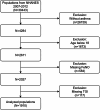Association between triglyceride-glucose index and fractional exhaled nitric oxide in adults with asthma from NHANES 2007-2012
- PMID: 39488691
- PMCID: PMC11531688
- DOI: 10.1186/s12944-024-02323-6
Association between triglyceride-glucose index and fractional exhaled nitric oxide in adults with asthma from NHANES 2007-2012
Abstract
Background: Several studies have shown a potential relationship between triglyceride-glucose index (TGI) and asthma. However, limited research has been conducted on the relationship between TGI and fractional exhaled nitric oxide (FeNO).
Methods: A total of 1,910 asthmatic individuals from the National Health and Nutrition Examination Survey (NHANES) database were included in this study. Linear regression analyses were used to investigate the relationship between TGI and FeNO in patients with asthma. Subsequently, a trend test was applied to verify whether there was a linear relationship between the TGI and FeNO. Finally, a subgroup analysis was performed to confirm the relationship among the different subgroup populations.
Results: Multivariable linear regression analyses showed that TGI was linearly related to FeNO in the asthmatic population. The trend test additionally validated the positive linear relationship between TGI and FeNO. The result of XGBoost revealed the five most influential factors on FeNO in a ranking of contrasted importance: eosinophil (EOS), body mass index (BMI), poverty-to-income ratio (PIR), TGI, and white blood cell count (WBC).
Conclusions: This investigation revealed a positive linear relationship between TGI and FeNO in patients with asthma. This finding suggests a potential relationship between TGI and airway inflammation in patients with asthma, thereby facilitating the prompt identification of irregularities and providing a basis for clinical decision making. This study provides a novel perspective on asthma management.
Keywords: Asthma; Fractional exhaled nitric oxide (FeNO); Triglyceride-glucose index (TGI); XGBoost.
© 2024. The Author(s).
Conflict of interest statement
The authors declare no competing interests.
Figures
References
-
- Xu Q, Zhou Q, Chen J, Li T, Ma J, Du R, et al. The incidence of asthma attributable to temperature variability: an ecological study based on 1990–2019 GBD data. Sci Total Environ. 2023;904: 166726. - PubMed
-
- Patel KB, Mims JW, Clinger JD. The Burden of asthma and allergic rhinitis: epidemiology and health care costs. Otolaryngol Clin North Am. 2024;57(2):179–89. - PubMed
-
- Shin YH, Hwang J, Kwon R, Lee SW, Kim MS, Shin JI, et al. Global, regional, and national burden of allergic disorders and their risk factors in 204 countries and territories, from 1990 to 2019: a systematic analysis for the global burden of Disease Study 2019. Allergy. 2023;78(8):2232–54. - PMC - PubMed
MeSH terms
Substances
Grants and funding
LinkOut - more resources
Full Text Sources
Medical



